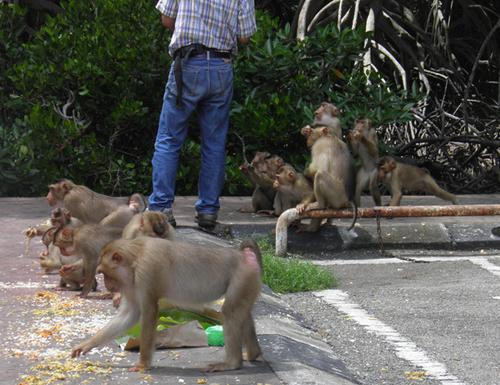当前位置:
X-MOL 学术
›
Am. J. Primatol.
›
论文详情
Our official English website, www.x-mol.net, welcomes your
feedback! (Note: you will need to create a separate account there.)
The human-primate interface in the New Normal: Challenges and opportunities for primatologists in the COVID-19 era and beyond.
American Journal of Primatology ( IF 2.0 ) Pub Date : 2020-07-20 , DOI: 10.1002/ajp.23176 Susan Lappan 1, 2 , Suchinda Malaivijitnond 3, 4 , Sindhu Radhakrishna 5 , Erin P Riley 6 , Nadine Ruppert 2
American Journal of Primatology ( IF 2.0 ) Pub Date : 2020-07-20 , DOI: 10.1002/ajp.23176 Susan Lappan 1, 2 , Suchinda Malaivijitnond 3, 4 , Sindhu Radhakrishna 5 , Erin P Riley 6 , Nadine Ruppert 2
Affiliation

|
The emergence of SARS‐CoV‐2 in late 2019 and human responses to the resulting COVID‐19 pandemic in early 2020 have rapidly changed many aspects of human behavior, including our interactions with wildlife. In this commentary, we identify challenges and opportunities at human–primate interfaces in light of COVID‐19, focusing on examples from Asia, and make recommendations for researchers working with wild primates to reduce zoonosis risk and leverage research opportunities. First, we briefly review the evidence for zoonotic origins of SARS‐CoV‐2 and discuss risks of zoonosis at the human–primate interface. We then identify challenges that the pandemic has caused for primates, including reduced nutrition, increased intraspecific competition, and increased poaching risk, as well as challenges facing primatologists, including lost research opportunities. Subsequently, we highlight opportunities arising from pandemic‐related lockdowns and public health messaging, including opportunities to reduce the intensity of problematic human–primate interfaces, opportunities to reduce the risk of zoonosis between humans and primates, opportunities to reduce legal and illegal trade in primates, new opportunities for research on human–primate interfaces, and opportunities for community education. Finally, we recommend specific actions that primatologists should take to reduce contact and aggression between humans and primates, to reduce demand for primates as pets, to reduce risks of zoonosis in the context of field research, and to improve understanding of human–primate interfaces. Reducing the risk of zoonosis and promoting the well‐being of humans and primates at our interfaces will require substantial changes from “business as usual.” We encourage primatologists to help lead the way.
中文翻译:

新常态下的人类与灵长类动物的相互作用:COVID-19 时代及以后灵长类动物学家的挑战和机遇。
2019 年底 SARS-CoV-2 的出现以及 2020 年初人类对由此产生的 COVID-19 大流行的反应迅速改变了人类行为的许多方面,包括我们与野生动物的互动。在这篇评论中,我们根据 COVID-19 确定了人与灵长类动物相互作用的挑战和机遇,重点关注亚洲的例子,并为研究野生灵长类动物的研究人员提出建议,以降低人畜共患病风险并利用研究机会。首先,我们简要回顾了 SARS-CoV-2 人畜共患病起源的证据,并讨论了人与灵长类动物接触面的人畜共患病风险。然后,我们确定了大流行给灵长类动物带来的挑战,包括营养减少、种内竞争加剧和偷猎风险增加,以及灵长类动物学家面临的挑战,包括失去研究机会。随后,我们强调了与大流行相关的封锁和公共卫生信息传递带来的机会,包括减少有问题的人与灵长类动物接触强度的机会、减少人类和灵长类动物之间人畜共患病风险的机会、减少灵长类动物合法和非法贸易的机会、人类与灵长类动物界面研究的新机会以及社区教育的机会。最后,我们建议灵长类动物学家应采取具体行动,以减少人类与灵长类动物之间的接触和攻击,减少对灵长类动物作为宠物的需求,减少实地研究中人畜共患病的风险,并增进对人与灵长类动物相互作用的理解。降低人畜共患疾病的风险并促进人类和灵长类动物在我们的界面上的福祉将需要对“一切照旧”进行重大改变。我们鼓励灵长类动物学家帮助带路。
更新日期:2020-07-24
中文翻译:

新常态下的人类与灵长类动物的相互作用:COVID-19 时代及以后灵长类动物学家的挑战和机遇。
2019 年底 SARS-CoV-2 的出现以及 2020 年初人类对由此产生的 COVID-19 大流行的反应迅速改变了人类行为的许多方面,包括我们与野生动物的互动。在这篇评论中,我们根据 COVID-19 确定了人与灵长类动物相互作用的挑战和机遇,重点关注亚洲的例子,并为研究野生灵长类动物的研究人员提出建议,以降低人畜共患病风险并利用研究机会。首先,我们简要回顾了 SARS-CoV-2 人畜共患病起源的证据,并讨论了人与灵长类动物接触面的人畜共患病风险。然后,我们确定了大流行给灵长类动物带来的挑战,包括营养减少、种内竞争加剧和偷猎风险增加,以及灵长类动物学家面临的挑战,包括失去研究机会。随后,我们强调了与大流行相关的封锁和公共卫生信息传递带来的机会,包括减少有问题的人与灵长类动物接触强度的机会、减少人类和灵长类动物之间人畜共患病风险的机会、减少灵长类动物合法和非法贸易的机会、人类与灵长类动物界面研究的新机会以及社区教育的机会。最后,我们建议灵长类动物学家应采取具体行动,以减少人类与灵长类动物之间的接触和攻击,减少对灵长类动物作为宠物的需求,减少实地研究中人畜共患病的风险,并增进对人与灵长类动物相互作用的理解。降低人畜共患疾病的风险并促进人类和灵长类动物在我们的界面上的福祉将需要对“一切照旧”进行重大改变。我们鼓励灵长类动物学家帮助带路。











































 京公网安备 11010802027423号
京公网安备 11010802027423号